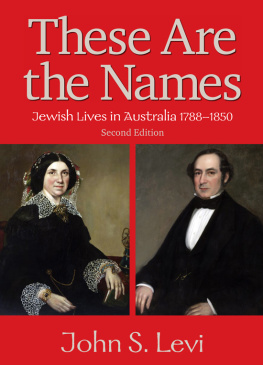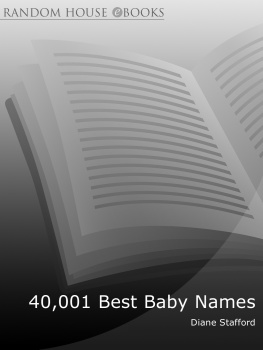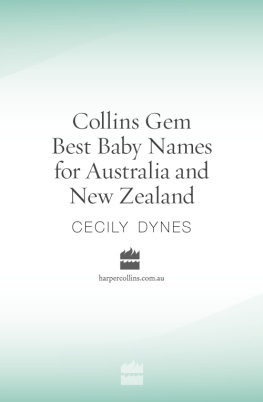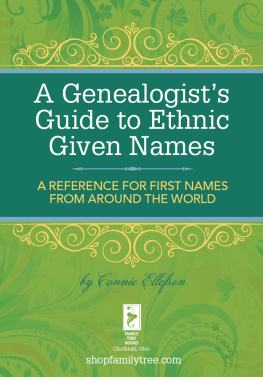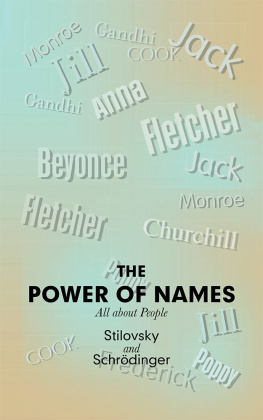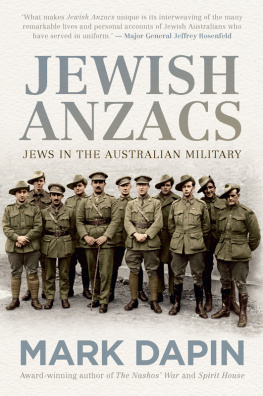THE MIEGUNYAH PRESS
The general series of the
Miegunyah Volumes
was made possible by the
Miegunyah Fund
established by bequests
under the wills of
Sir Russell and Lady Grimwade.
Miegunyah was the home of
Mab and Russell Grimwade
from 1911 to 1955.
These Are the Names
Jewish Lives in Australia, 17881850
Second Edition
John S. Levi

THE MIEGUNYAH PRESS
An imprint of Melbourne University Publishing Limited
1115 Argyle Street South, Carlton, Victoria 3053, Australia
www.mup.com.au
First published 2006
This edition published 2013
Text John Simon Levi 2013
Design and typography Melbourne University Publishing Ltd 2013
This book is copyright. Apart from any use permitted under the
Copyright Act 1968 and subsequent amendments, no part may be
reproduced, stored in a retrieval system or transmitted by any means or
process whatsoever without the prior written permission of the
publishers.
Edited by Sally Nicholls
Designed by Alice Graphics
Typeset in Bembo 11/12.5 point
by diacriTech Client Service
Printed by ABC in China
National Library of Australia Cataloguing-in-Publication entry
Levi, J. S. (John Simon), 1934 .
These are the names: Jewish lives in Australia, 17881850.
Bibliography.
Includes index.
9780522862294 (hbk.).
1. JewsAustraliaRegisters. 2. AustraliaHistory
17881851Sources. I. Title.
305.8924094
Foreword
C ONVICTS AND FREE, FAMILIES and friends, villains and professional, healthy and sick, maimed and whole, wily and worthy, short and tall, all is revealed in this amazing book detailing Australia's first Jewish settlers. From the departure of the First Fleet in 1787 and for the sixty-three years thereafter, John Levi has produced a record detailing all the Jewish migrants, both voluntary and less so, who came to what is now Australia. It is as comprehensive, entertaining and educative but less divine than the Book of Exodus, despite being written by an emeritus Rabbi. I have no doubt that, in time, it will be treated as authoritatively. Fortunately this is not a book of begats but a scholarly composition about the more than 1600 Jews who were transported or who chose Australia as a home, from the very first moment of European settlement up to 1850, just before the face of Australia changed for ever with the discovery of gold.
Australia was founded as an outpost of a British government department, the present-day equivalent of the Office of Corrections. Those to be corrected were tutored by the marines and navy who, it could be said, were from just the other side of the law. Being militarily bureaucratic all noteworthy acts, together with personal details of the perpetrators, were written down in beautiful copperplate. The convict records are particularly ample. Details such as complexion, height, individual mutilations, tattoos and scars are all noted. Free settlers were not so thoroughly treated. Nevertheless the ship indents recorded all passengers, and government land and licence records enable their passages through life to be traced. Using primary sources, supplemented by newspaper reports and occasional articles, this book cascades with facts. Every lash applied to a Jewish back, every act of recalcitrance and almost every mitzvah is set down. The book itself will become source and prime material for future generations of historians.
Basic source though this book is, some of the subtexts and the necessary implications they raise are just as beguiling. For example, the skeins of chain migration can be unravelled. How is it that one family member enticed others to follow and in what order? The factors that pushed them out of Britain, as well as those that pulled them to Australia are revealed. Why, among those who were materially successful, did some return to Britain and others remain? Even the details of the states of health of the convicts raise interesting questions. The survival rates of adults and, more significantly, of children can be traced. The book raises the issue of what effect upon family life, especially upon women, was the fact that most could reasonably expect their children to live into maturity and beyond that to old age? These are the questions the book provokes, and it provides us with the foundation to continue to ask demanding questions.
The book exposes an astounding story of Jewish fortitude and resilience. One per cent of the convicts on the First Fleet were Jewsa population percentage not since matched. Within a short time the structures of Jewish survival were in place. The book refers to the benevolent societies, the appropriate burial rituals and the formal list of synagogue donors. A further fascinating issue is unmasked, that of why so many Jews sought to establish Jewish life in difficult circumstances and why so many did not. How many Australians of our present generation must have Jewish antecedents? This book partially answers the questionhundreds of thousands. This is a unique picture of a whole communityrich and poor, emancipist, male and female, free settler and convict. So often history is reserved for the powerful or the wealthy. Australia's extraordinary wealth of records gives us a fresh perspective on the past.
The author has given new meaning to the words industry and competence. In my view this book surpasses his previous publications. Rabbi Levi has transformed the dry records of colonial history into a series of engaging personal stories. Here you will meet Australia's first musician, a wizard, our first actors and theatrical producers, many of Australia's first business men and women. There are pastoral pioneers, brewers and farmers. There are convicts who made good and convicts who suffered terrible punishments and whose lives were forever shattered. There are Jewish converts to Christianity and Gentiles who became Jews. In this book we meet the hapless Raphael Harris who, it is noted, may well have been the first Hungarian to arrive in Australia. He understood distilling in all its branches. He had thick lips, but no whiskers. Raphael was transported for seven years for stealing a watch. In May 1831 he was given ten lashes for cutting up his blanket, and later another twelve for refusing to work. He capped his life by drowning at New Norfolk in Tasmania on Christmas Eve 1832. There is much to read about Raphael, and thousands upon thousands of facts about the other arrivals.
John Levi has given life to our history and in the telling of an entire community has bestowed dignity and meaning to our forefathers and mothers. It adorns Jewish learning wherever and whenever it is read. It has been the greatest honour to have written this foreword.
The Hon. Howard Nathan QC
Acknowledgements
M Y THANKS TO THE Pratt Cultural Fund, chaired by Mr Sam Lipski AO. I am grateful for the sympathetic friendship of Mrs Jeannie Pratt AO. Their support of educational, cultural and charitable projects in Australia and in Israel has no parallel.
I extend my gratitude to the Australian Jewish Historical Society with its branches in Victoria and New South Wales and presidents Dr Howard Freeman and Mrs Helen Bersten respectively. The painstaking work of Ms Jeannette Tsoulos and Ms Rieke Nash of the Australian Jewish Genealogical Society in New South Wales was invaluable. My thanks to the enthusiastic support of Mr Lionel Sharpe OAM, President of the Australian Jewish Genealogical Society in Victoria and Ms Sophie Caplan OAM, President of the Australian Jewish Historical Society in New South Wales. The Archives of the New South Wales Genealogical Society are housed at Mandelbaum House at the University of Sydney and the help of Ms Naomi Winton is acknowledged together with the support of Mrs Helen Bersten. The archives of the Great Synagogue were generously made available to me and my thanks go to Rabbi Emeritus Raymond Apple AO. I acknowledge the support of the Hyde Park Museum, its curator at the time, Mr John Petersen, and the Historic Houses Trust of New South Wales. Over the past forty or so years I have studied the records of the Hobart Hebrew Congregation and the Archives of Tasmania, which are now online. This edition is the result of an initiative envisaged by my friend, Mr Peter M Schiftan.
Next page
